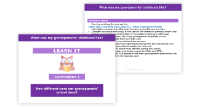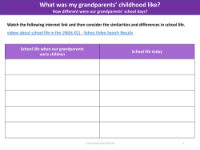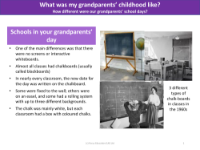How different were our grandparents' school days? - Presentation

History Resource Description
Exploring the contrast between contemporary school life and that of our grandparents' era can be a fascinating journey into the past. Classrooms in the 1960s and 1970s were markedly different, with chalkboards as the mainstay of visual aids, instead of the interactive whiteboards and screens we see today. Students would begin each day by viewing the new date written on the chalkboard, which could be fixed to the wall, placed on an easel, or even part of a rolling system. Chalk was primarily white, but a box of coloured chalks was a common sight in every classroom. The attire of students was less formal too, with most children wearing their everyday clothes to school, as school uniforms were not as prevalent. Additionally, the provision of free milk for all children was a standard practice, aimed at improving the health of post-war youngsters with poor diets.
Health and hygiene also featured prominently in the school routine. Nurses, often referred to endearingly as 'nit nurses', would regularly visit schools to check for nits in students' hair, while dentists made their rounds to inspect and treat children's teeth. Classroom furniture had its own unique characteristics, with desks often having lids for storage and inkwells for pens dipped in ink, necessitating the use of blotting paper to prevent smudges. Classroom layouts too have evolved; rows of desks were common until the 1960s, with the noisier or naughtier students seated at the front, but this changed as the decade progressed, with classrooms becoming less silent and more group-oriented. To delve deeper into this history, students are encouraged to create a list of questions to ask their grandparents about their school experiences, covering topics like discipline, classroom environment, and the presence of health professionals, providing a personal and engaging link to the past.




